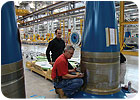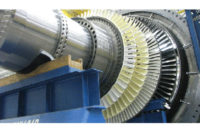
During the past three years, U.S. power companies increased their wind power capacity by 58 percent, from 25,410 megawatts in 2008 to 40,180 megawatts in 2010. The increase represents some 9,800 individual turbines.
That trend has been a boon for American manufacturing. More than 400 manufacturing facilities across the United States now make wind turbines or components for them. One of the largest of these facilities is Nordex USA Inc.’s new turbine assembly plant in Jonesboro, AR.
Nordex broke ground for the facility in September 2009 and completed construction in July 2010. Production began Oct. 4, 2010. Operating on a single shift, the plant can produce 300 turbines annually.
“About 20 percent of the market growth for wind turbines over the next few years will be in the United States,” says Bill Pixley, director of production at the plant. “Based on that, we felt that it was best to have a made-in-the-U.S.A. product.”
The $42 million factory consists of 115,000 square feet of manufacturing space, 35,000 square feet of office space, and 10,000 square feet of training space. Nordex acquired 187 acres of land for the project, but is currently using only 45 acres. Depending on the market, the company plans to use the remaining space to build a blade manufacturing facility in two or three years.
The factory produces a 2.5-megawatt turbine, which consists of three major subassemblies-the hub, the drivetrain and the nacelle. The blades are attached to the hub, which can change their pitch to adjust the speed of rotation. The drivetrain consists of the rotor shaft, gearbox and generator. The nacelle houses the drivetrain and an electronic control system that keeps the turbine pointed into the wind.
“These are quite heavy components,” says Pixley. “The hub is approximately 30 tons. Without the generator, the drivetrain is 50 tons, and the nacelle is 42 tons.”
To move such huge subassemblies, the plant is equipped with 22 heavy-duty cranes, the largest of which can carry an 80-ton load.
As large as the facility is, it’s strictly an assembly operation. Machining and fabrication are done by outside suppliers.
In the past, Nordex assembled turbines using a stall-build process. However, given a blank slate, Nordex wanted the Jonesboro plant to have moving assembly lines. Conveyors and rail lines transport subassemblies from one station to the next. “It’s just like an automotive assembly line,” says Pixley. “Obviously, it’s slower. We’re not producing 60 or 70 turbines an hour, but we do have a moving line. It has improved our efficiency tremendously.”
Another specialized technology at the plant is the hydraulic equipment for tightening threaded fasteners. “We use some extremely large bolts,” says Pixley. “We have torques in the 3,000 newton-meter range.”
The plant already employs 80 people, and plans to have a staff of more than 100 by year’s end. Before production began, new hires spent 10 weeks training at Nordex’s assembly plant in Rostock, Germany.
“The best asset we have is our people-they have been phenomenal,” boasts Pixley. “We’re still working on some efficiencies and constraints, but it’s been a beautiful launch.”
Editor’s note: “Moving Forward” is a regular series profiling new or expanding assembly plants. If you know a facility that’s opening, growing or investing in new equipment, we’d like to hear about it. Send an e-mail to John Sprovieri, editor of ASSEMBLY, at sprovierij@bnpmedia.com, or call 630-694-4012.
